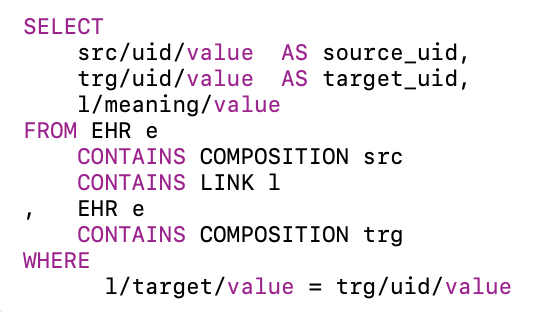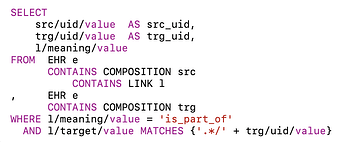Thank you very much for your support!
The folder approach is considered a good and preferred solution. May I ask a few questions about FOLDERS?
I have created an example based on various openEHR literature sources and attached it to this entry with the following ideas:
- Create a separate folder called ‘Administrative Cases’ below the root folder for administrative cases
- Create a separate subfolder for each administrative case
- This subfolder has a description in the form of “archetype_node_id”, where the desired attributes are stored under ‘details’.
- The archetype is usually listed as ‘archetype_node_id’: ‘openEHR-EHR-FOLDER.generic.v1’. I have used “archetype_node_id”: ‘openEHR-EHR-FOLDER.administrative_case.v1’.
- All compositions can then be stored in a folder of the corresponding administrative case under ‘Items’.
- All modifications are automatically versioned in the CDR
- Additional folders can be created at the same level as ‘Administrative Cases’ below the root folder, e.g. for diagnostic results, visits, etc.
My questions:
- Does this example/suggestion correspond to best practices?
- Currently, you have to load all folders to add a composition to a specific folder or subfolder (Get/Put). Is it possible to load and update only a subfolder, e.g. only the ‘Administrative Cases’ folder without always loading all folders?
- Is it advisable to create a separate folder with subfolders for each case to map the administrative cases?
- An archetype is used to store the attributes for a case, by default ‘openEHR-EHR-FOLDER.generic.v1’. Is it permissible and better to use other archetypes for a folder, e.g. ‘openEHR-EHR-FOLDER.administrative_case.v1’?
- How can I load my FOLDER archetypes into the CDR so that they are available for validating the details when saving?
POST Create directory (tested in EHRBase)
{
"_type": "FOLDER",
"name": { "_type": "DV_TEXT", "value": "root" },
"archetype_node_id": "openEHR-EHR-FOLDER.generic.v1",
"folders": [
{
"_type": "FOLDER",
"name": { "_type": "DV_TEXT", "value": "Administrative Cases" },
"archetype_node_id": "openEHR-EHR-FOLDER.generic.v1",
"folders": [
{
"_type": "FOLDER",
"name": { "_type": "DV_TEXT", "value": "Admin Case 1" },
"archetype_node_id": "openEHR-EHR-FOLDER.administrative_case.v1",
"details": {
"_type": "ITEM_TREE",
"items": [
{
"_type": "ELEMENT",
"name": { "value": "case_id" },
"value": { "_type": "DV_IDENTIFIER", "id": "AC-2025-001" }
},
{
"_type": "ELEMENT",
"name": { "value": "case_description" },
"value": { "_type": "DV_TEXT", "value": "Inpatient cardiology case" }
},
{
"_type": "ELEMENT",
"name": { "value": "start_date" },
"value": { "_type": "DV_DATE_TIME", "value": "2025-01-10T09:00:00Z" }
},
{
"_type": "ELEMENT",
"name": { "value": "end_date" },
"value": { "_type": "DV_DATE_TIME", "value": "2025-01-15T17:00:00Z" }
}
]
},
"folders": [],
"items": []
},
{
"_type": "FOLDER",
"name": { "_type": "DV_TEXT", "value": "Admin Case 2" },
"archetype_node_id": "openEHR-EHR-FOLDER.administrative_case.v1",
"details": {
"_type": "ITEM_TREE",
"items": [
{
"_type": "ELEMENT",
"name": { "value": "case_id" },
"value": { "_type": "DV_IDENTIFIER", "id": "AC-2025-002" }
},
{
"_type": "ELEMENT",
"name": { "value": "case_description" },
"value": { "_type": "DV_TEXT", "value": "Inpatient dermatology case" }
},
{
"_type": "ELEMENT",
"name": { "value": "start_date" },
"value": { "_type": "DV_DATE_TIME", "value": "2025-03-03T08:30:00Z" }
},
{
"_type": "ELEMENT",
"name": { "value": "end_date" },
"value": { "_type": "DV_DATE_TIME", "value": "2025-03-03T12:00:00Z" }
}
]
},
"folders": [],
"items": []
}
],
"items": []
},
{
"_type": "FOLDER",
"name": { "_type": "DV_TEXT", "value": "Folder 2" },
"archetype_node_id": "openEHR-EHR-FOLDER.generic.v1",
"folders": [],
"items": []
},
{
"_type": "FOLDER",
"name": { "_type": "DV_TEXT", "value": "Folder 3" },
"archetype_node_id": "openEHR-EHR-FOLDER.generic.v1",
"folders": [],
"items": []
}
],
"items": []
}

